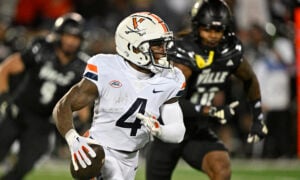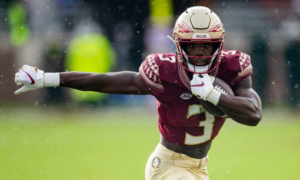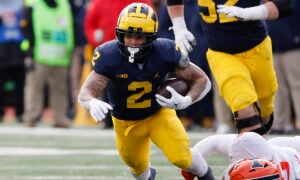Turning Back the Clock: Aging WR Performances
 We’ve already looked at how quarterbacks and running backs produce as they age. If you missed those, take a look at the quarterback and the running back studies. In third and final part of this series, we will take a look at how some of the best wide receivers of their time aged and what happened at the end of their careers. Hopefully this will help to shed some light on what we can expect from today’s aging WR1s like Andre Johnson, Roddy White, and Reggie Wayne.
We’ve already looked at how quarterbacks and running backs produce as they age. If you missed those, take a look at the quarterback and the running back studies. In third and final part of this series, we will take a look at how some of the best wide receivers of their time aged and what happened at the end of their careers. Hopefully this will help to shed some light on what we can expect from today’s aging WR1s like Andre Johnson, Roddy White, and Reggie Wayne.
The process is very similar to what was done in the running back study. In order to qualify, a player had to dominate his peers for a few years and/or put up consistent WR1 numbers for several years. The age of the player at the start of their best season, second best season, and their last season with WR1 level production. In addition, any extenuating circumstances, if they exist, about their career such as team changes or major injuries are given as well as what happened after their last year of WR1 production. For reference, I drew the cutoff line for WR1 production at 240 points in a PPR league with standard scoring. This would roughly place the player in the top 12 wide receivers for each of the last few years.
Just a quick reminder, the ages of the players are their age at the start of the NFL season. The names are in no particular order.
Marvin Harrison
Age before his best season: 29
Age before his second best season: 30
Age before his last WR1 season: 34
End of his career: He suffered a serious knee injury during his age 35 season. He came back, but wasn’t his former self during his age 36 season which was his last in the league due to ineffectiveness and off the field issues.
Torry Holt
Age before his best season: 27
Age before his second best season: 28
Age before his last WR1 season: 31
End of his career: Holt had a massive decline in his stats entering his age 32 season. He tried a new team when he was 33, but that didn’t help him out – he retired after that season.
Hines Ward
Age before his best season: 26
Age before his second best season: 27
Age before his last WR1 season: 33
End of his career: Ward saw a severe drop off in his stats during his age 34 season which corresponds to the breakout of Mike Wallace. He stuck around for another year before retiring after his age 35 season.
Jerry Rice
Age before his best season: 33
Age before his second best season: 32
Age before his last WR1 season: 40
Special notes: Rice’s greatest season just might have been his strike shortened season when he was only 25 years old. In the 12 game season, he notched a then record 22 touchdowns. However, since it was only 12 games his season totals weren’t equal to those in his 30s.
End of his career: Rice actually played until he was 42 years old, but he didn’t have a fantasy worthy season after his age 40 season.
Rod Smith
Age before his best season: 31
Age before his second best season: 30
Age before his last WR1 season: 35
End of his career: Like several others, Smith suffered a steep statistical decline. His came during his age 36 season before he retired.
Isaac Bruce
Age before his best season: 28
Age before his second best season: 27
Age before his last WR1 season: 32
End of his career: Although his last WR1 year was when he was 32, his receptions and yards continued at that level until he was 34 – he just didn’t score many touchdowns in those years. He continued to play until he was 37, but his stats dropped significantly after his age 34 season.
Joe Horn
Age before his best season: 32
Age before his second best season: 28
Age before his last WR1 season: 32
End of his career: He received a big contract after his age 32 season. During his age 33 seaso,n he started to struggle with injuries, missing three games that season as his play fell off. His age 34 season was even worse as he missed seven starts that year. He played for Atlanta when he was 35 and failed to produce on the field, though Roddy White does give Horn a whole lot of credit for helping him unlock his potential.
Cris Carter
Age before his best season: 30
Age before his second best season: 34
Age before his last WR1 season: 35
End of his career: Carter also had a pretty quick drop off after his last productive season. He produced at a WR1 level when he was 35 and was out of the league after his age 37 season.
Jimmy Smith
Age before his best season: 30
Age before his second best season: 32
Age before his last WR1 season: 32
End of his career: Unlike several others, Smith’s drop off wasn’t as extreme. He remained a decent WR2 through his age 36 season.
Keyshawn Johnson
Age before his best season: 26
Age before his second best season: 27
Age before his last WR1 season: 29
End of his career: Johnson was younger than most when he hit is peak and didn’t produce at an elite level for as long. A big reason might be the many different teams that he played for through his late 20s and early 30s. He did remain at a WR2 level through his age 34 season.
Joey Galloway
Age before his best season: 34
Age before his second best season: 26
Age before his last WR1 season: 34
End of his career: He produced for a few different teams and was a solid WR2 until age 36. Injuries struck when he was 37 and robbed him of all effectiveness.
Andre Reed
Age before his best season: 25
Age before his second best season: 30
Age before his last WR1 season: 30
End of his career: He peaked earlier than most and didn’t last at a WR1 level for quite as long, but he remained a solid WR2 through his age 34 season.
Sterling Sharpe
Age before his best season: 27
Age before his second best season: 29
Age before his last WR1 season: 29
Special notes: Had the second most touchdowns in a season at the time when he posted 18 touchdowns in 1994, his age 29 season.
End of his career: Sharpe looked to be just entering his prime at age 29, looking unstoppable with Brett Favre as his quarterback. Unfortunately he suffered a career ending neck injury and never played in his 30s.
Michael Irvin
Age before his best season: 29
Age before his second best season: 25
Age before his last WR1 season: 31
End of his career: Irvin posted WR2 numbers during his age 32 season. His career quickly came to an end when he suffered a career ending spine injury during the fifth game of his age 33 season.
Steve Largent
Age before his best season: 30
Age before his second best season: 25
Age before his last WR1 season: 32
End of his career: Largent dominated his time, even though his numbers don’t look too special compared to a lot of guys today. Nonetheless, he was still posting WR2 level numbers through his age 34 season.
Summary
Let’s look at a few stats on what these numbers turned up. Mean – same as average. Mode – Most common number. Median – Middle number when in order.
Best season: Mean – 29.1, Median – 29, Mode – 30, High – 34, Low – 25
Second Best: Mean – 28.7, Median – 28, Mode – 30, High – 34, Low – 25
Last WR1 year: Mean – 32.6, Median – 32, Mode – 32, High – 40, Low – 29
It was a little bit surprising to see that the numbers show that the best years for elite wide receivers seem to be right around the age of 29. Not only that, but nearly half of the wide receivers we looked at peaked when they were in their 30s. We tend to think of the physical prime as being in the mid-twenties, but it seems that there is a certain experience and mental side of the game that needs to come along at the wide receiver position before they truly hit their peak.
When it comes to producing at a WR1 level, this seems to continue through their early 30s, right around the age of 32. Five of the wide receivers even made it to age 34 or 35 while producing at very high levels, but only the great Jerry Rice produced WR1 numbers after the age of 35. In other words, don’t count on WR1 production after age 35 from anyone.
The most interesting and possibly important part of all of this is what happened after their WR1 days were done. A little over half of the wide receivers saw a drastic decline after their last WR1 season and were out of the league within a year or two. Often times this was due to injuries to knees or necks. The ones that didn’t see that severe drop off continued to produce at a WR2 level into their mid-thirties. There doesn’t really seem to be a glaring signal to tell which receivers will see that steep decline but injuries seem to be a decent part of it.
What does all of this mean for some of the aging wide outs in the league right now?
Players in their mid-thirties like Reggie Wayne (33 years old) or Randy Moss (35 years old) aren’t very likely to produce at a WR1 level. However, there is a pretty good chance that they could produce at a WR2 level for a few more years, probably more likely for Wayne than Moss. Players just entering or about to enter their 30s like White or Vincent Jackson could still post very solid WR1 numbers for a few more years as long as they stay healthy. The mention of health brings us to Andre Johnson, one of the premier receivers over the last few years. At 31 years old with some injury issues over the last few years, he might have already hit that steep decline that we saw with guys like Horn and Harrison after their injuries. He might come back and light it up this year since he is younger than they were when the injuries struck, but the research shows it is far from a sure thing.
Here is the bottom line for what to expect from your elite WRs: they tend to peak around age 29, can stay at WR1 levels well through their early 30s, and if they remain healthy they can keep producing at WR2 levels through their mid-30s. We see steep declines in production or players not lasting as long as they should mostly when there are lower body or neck injuries.
- Final 2021 Pre-Draft Rookie Mock: Round Three - April 28, 2021
- Final 2021 Pre-Draft Rookie Mock: Round Two - April 26, 2021
- Final 2021 Pre-Draft Rookie Mock: Round One - April 25, 2021


































































